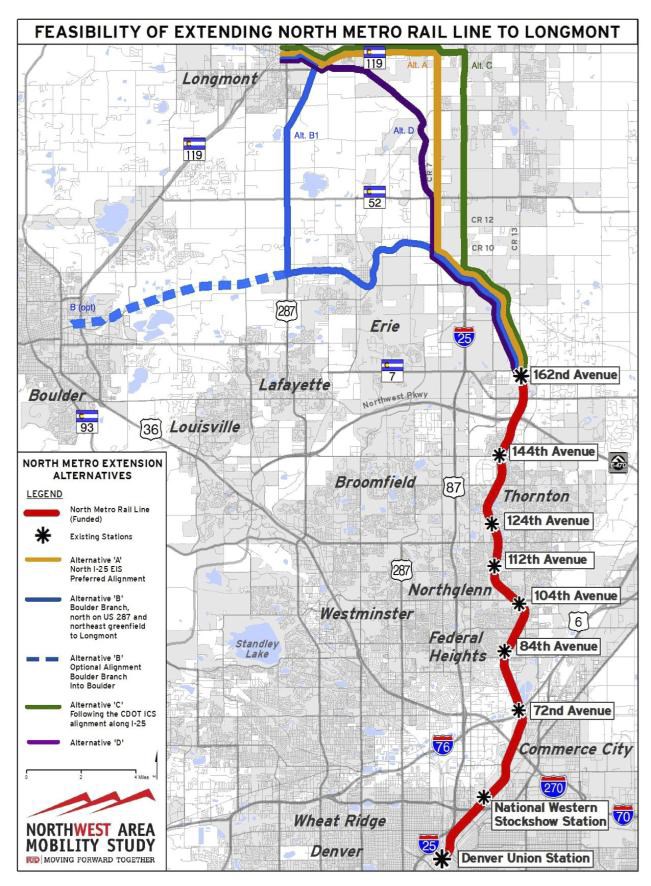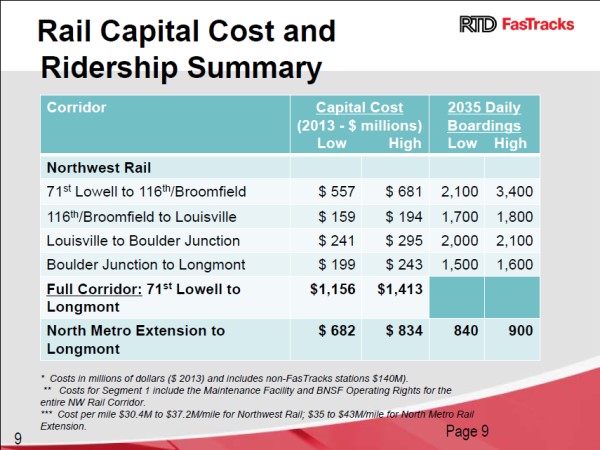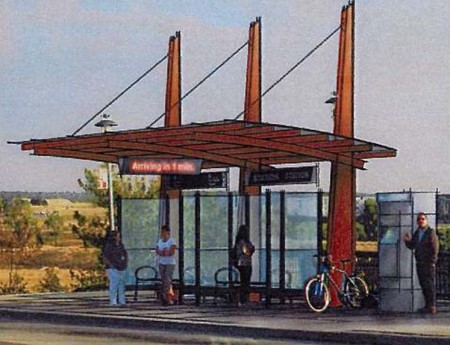At a PLAN-Boulder forum on Friday, November 1, Chuck Sisk, representative to RTD’s board of directors from District O (which includes most of Boulder County), asserted that a state-wide coalition called Impact 64 is seriously considering trying to place a 15-year, seven-tenths of one percent sales and use tax for transportation needs around Colorado on the November, 2014 ballot and implied that passage of the measure would probably greatly accelerate the current schedule for completing the Northwest Rail line to Louisville, Boulder and Longmont, among other cities.
Sisk said that Impact 64 has been contemplating the allocation of $1.8 billion of the proceeds of the sales and use tax to RTD and noted that Northwest Rail is now estimated to cost up to $1.4 billion to complete. He did not speculate on the effect of the resounding defeat of Amendment 66 on the proposed transportation tax, because this forum occurred before this fall’s election results were known. Sisk said that a higher gasoline tax or a vehicle miles traveled (VMT) tax had been excluded from consideration because they were deemed politically infeasible.
Sisk stated that Impact 64 included representatives from every part of the state, including the Western Slope, which, he remarked, “is afraid of being left out of state transportation money.” He commented, “You don’t win transportation elections in Colorado without Boulder County.” However, he recognized that before Boulder County supported such a tax, its residents would probably have to believe that substantial progress on Northwest Rail is happening. To create that impression, Sisk said that RTD is examining the possibility of building Northwest Rail in four, consecutive segments with the first to be finished relatively quickly.
Sisk was joined at the forum by Chris Quinn, RTD’s planning project manager for the northwest area. They also talked about RTD’s Northwest Area Mobility Study and the status of Bus Rapid Transit (BRT) along US 36 and elsewhere in the northwest area, SMART cards, and community-wide EcoPasses.
Northwest Area Mobility Study
The Northwest Area Mobility Study is intended to assess ways to provide high-volume transit service in the northwest area before 2042. However, Sisk said that more exotic concepts, such as monorail or a new railroad line parallel to US 36, were quickly eliminated as possibilities. The study was commissioned by the RTD board in March, 2013, at a cost of $2.2 million, and it is expected to be concluded in February, 2014, after a series of public meetings next January. From the comments of Sisk and Quinn, it appeared that the study is concentrating on: (1) determining the final elements to complete BRT on US 36, (2) examining how Northwest Rail might be built in segments, (3) evaluating the feasibility of providing rail service to Longmont from a route running along I-25 and then veering to the west, and (4) evaluating “arterial BRT” corridors throughout the northwest region.
Sisk suggested that the study already seems to indicate that a separate rail line to Longmont would not be financially feasible, and he noted that it would not serve any of the considerable number of people who travel just between Longmont and Boulder. Quinn and Sisk presented the following estimate of costs for “segmented” construction of Northwest Rail, ridership, and the cost of a separate line to Longmont along 1-25:
Sisk observed that the cost of the first segment would be particularly high, because it would include a huge, one-time fee to BNSF just to use its right-of-way. He also said that 10,000 feet of “chambering track” would have to be installed at the end of each segment to accommodate freight trains while they stopped to let passenger trains proceed. These “chambering tracks” cannot be located on a grade or at a street crossing, he said. Sisk held out some hope, however, that in the near future BNSF might propose providing adequate passenger service on its rail line, thereby greatly lowering capital costs. He noted that BNSF operates “the Sounder” passenger rail service in the Seattle-Tacoma area in conjunction with a public transportation authority.
“Arterial BRT” corridors are being considered for the following routes:
- SH 119; between Table Mesa Park ‘n Ride and Longmont (Bolt/Skip/205)
- South Boulder Road (Dash)
- SH 7 (Jump/225)
- US 287 (L/LX)
- SH 42 (new route)
- 120th Avenue (120)
Capital costs are estimated at between $255 and $300 million (in 2013 dollars) and ridership by 2035 is estimated to range between 16,300 and 26,600 a day. Sisk and Quinn disclosed that financing options for “arterial BRT” have not been developed, nor have priorities among the possible corridors been established.
BRT on US 36
Sisk said that BRT is currently scheduled to start service in 2016, but that he is pressing RTD to begin it in 2015. It will cover 18 miles between Boulder and Union Station in Denver and include six stations. Current RTD ridership on US 36 is 10,600 passengers a day. By 2035 RTD is projecting 20,400 riders a day on BRT and two to four minute “peak” bus frequencies and six to ten minute “off-peak” frequencies.
“It will be more than just another bus route,” Sisk declared. The BRT service will be “branded,” as will the vehicles. Fifty-nine vehicles will be used. However, their characteristics have not yet been determined, so it is now unknown whether they will be articulated, low-riding vehicles that do not require passengers to step up and down from the stations, or more like RTD’s current coaches in which the drivers and passengers sit high over baggage compartments. The BRT stations will feature bigger canopies and more weather protection than RTD’s current stations offer, ticket vending machines and SMART card readers for cashless fare collection, and programmable displays of transit schedule information. Wi-Fi will be offered on the buses and in the stations, and “real time” bus arrival information will be provided.
SMART Card
SMART cards are used by regular RTD passengers and are supposed to provide detailed information to RTD about where each passenger boards and exits each bus. The data from Smart cards has been deemed essential by RTD for determining the true cost of EcoPasses and establishing what the City of Boulder or Boulder County might be charged for EcoPasses for everyone residing, and perhaps working, within their jurisdictions. RTD also contends that SMART cards reduce fraud and administrative burdens.
Sisk and Quinn noted that the first phase of SMART cards was introduced in January of 2013. Over 300,000 SMART cards have been issued, they said. Sisk stated that RTD had originally expected to collect enough data by the end of this year. However, he said that that expectation has been pushed to February or March of 2014.
Community-wide EcoPasses
Sisk noted that a study of the coverage of a potential community-wide EcoPass, what local governments might be involved, and how it might be funded is now being conducted jointly for the City of Boulder and Boulder County by Charlier & Associates. He commented at one point, “I don’t think we will get to a community-wide EcoPass in Boulder”—apparently because of the probable cost. A member of the audience, Zane Selvans, who serves on the City’s Transportation Advisory Board, said that the board had recently received a preliminary estimate that EcoPasses throughout Boulder County would cost $21 million a year. Selvans said that all of the current funds spent on EcoPasses for Boulder County residents totals less than half of that.





